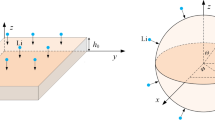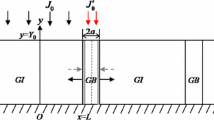Abstract
According to the diffusion kinetics and heteroepitaxial strained layer theory, this paper presents a theoretical model to investigate the generation and distribution of misfit dislocations in a thin film anode under galvanostatic and potentiostatic operations. The results show that the nucleation and density distribution of misfit dislocations largely depend on the thickness of the diffused layer and insertion time. When the thickness is less than a certain critical value, the total strain energy in the electrode is almost insusceptible and yet reduced by misfit dislocations for that of going beyond the critical value. Under potentiostatic operation, the rise range and response speed of the dislocation density are greater and faster. A certain region immediately possesses much lower dislocation density under the electrode surface compared with the region below it. These quantitative results can provide a new perspective into relieving diffusion-induced stress by misfit dislocations with the purpose of improving the mechanical durability of lithium-ion batteries.














Similar content being viewed by others
References
Armand M, Tarascon JM (2008) Building better batteries. Nature 451:652–657
Tarascon JM, Armand M (2001) Issues and challenges facing rechargeable lithium batteries. Nature 414:359–367
Goodenough JB, Kim Y (2010) Challenges for rechargeable Li batteries. Chem Mater 22:587–603
Cui L, Ruffo R, Chan CK, Peng H, Cui Y (2009) Crystalline-amorphous core-shell silicon nanowires for high capacity and high current battery electrodes. Nano Lett 9:491–495
Chan CK, Peng H, Liu G, McIlwrath K, Zhang X, Huggins RA, Cui Y (2008) High-performance lithium battery anodes using silicon nanowires. Nat Nanotechnol 3:31–35
Li X, Cho JH, Li N, Zhang Y, Williams D, Dayeh SA, Picraux ST (2012) Carbon nanotube-enhanced growth of silicon nanowires as an anode for high-performance lithium-ion batteries. Adv Energy Mater 2:87–93
Qin G, Ma Q, Wang C (2014) A new route for synthesizing C/LiFePO4/multi-walled carbon nanotube secondary particles for lithium ion batteries. Solid State Ionics 257:60–66
Rui X, Yan Q, Skyllas-Kazacos M, Lim TM (2014) Li3V2(PO4)3 cathode materials for lithium-ion batteries: a review. J Power Sources 258:19–38
Chen R, Zhao T, Wu W, Wu F, Li L, Qian J, Xu R, Wu H, Albishri HM, Al-Bogami AS, El-Hady DA, Lu J, Amine K (2014) Free-standing hierarchically sandwich-type tungsten disulfide nanotubes/graphene anode for lithium-ion batteries. Nano Lett 14:5899–5904
Ji L, Lin Z, Alcoutlabi M, Zhang X (2011) Recent developments in nanostructured anode materials for rechargeable lithium-ion batteries. Energy Environ Sci 4:2682–2699
Kim TH, Park JS, Chang SK, Choi S, Ryu JH, Song HK (2012) The current move of lithium ion batteries towards the next phase. Adv Energy Mater 2:860–872
Li X, Fang Q, Li J, Wu H, Liu Y, Wen P (2016) Analytical model for sandwich-lithiation in hollow amorphous silicon nano-anodes coated on carbon nanofibers. J Electrochem Soc 163:A163–A170
Obrovac MN, Christensen L (2004) Structural changes in silicon anodes during lithium insertion/extraction. Electrochem Solid-State Lett 7:A93–A96
Obrovac MN, Christensen L, Le DB, Dahn JR (2007) Alloy design for lithium-ion battery anodes. J Electrochem Soc 154:A849–A855
Kasavajjula U, Wang C, Appleby AJ (2007) Nano- and bulk-silicon-based insertion anodes for lithium-ion secondary cells. J Power Sources 163:1003–1039
Li X, Fang Q, Li J, Wu H, Liu Y, Wen P (2015) Diffusion-induced stress and strain energy affected by dislocation mechanisms in a cylindrical nanoanode. Solid State Ionics 281:21–28
Verbrugge MW, Baker DR, Xiao X, Zhang Q, Cheng YT (2015) Experimental and theoretical characterization of electrode materials that undergo large volume changes and application to the lithium-silicon system. J Phys Chem C 119:5341–5349
Wang J, Fan F, Liu Y, Jungjohann KL, Lee SW, Mao SX, Zhu T (2014) Structural evolution and pulverization of tin nanoparticles during lithiation-delithiation cycling. J Electrochem Soc 161:F3019–F3024
Huggins RA, Nix WD (2000) Decrepitation model for capacity loss during cycling of alloys in rechargeable electrochemical systems. Ionics 6:57–63
Huang J, Zhong L, Wang C, Sullivan JP, Xu W, Zhang L, Mao SX, Hudak NS, Liu X, Subramanian A, Fan H, Qi L, Kushima A, Li J (2010) In situ observation of the electrochemical lithiation of a single SnO2 nanowire electrode. Science 330:1515–1520
Wei P, Zhou J, Pang X, Liu H, Deng K, Wang G, Wu Y, Chen B (2014) Effects of dislocation mechanics on diffusion-induced stresses within a spherical insertion particle electrode. J Mater Chem A 2:1128–1136
Li J, Fang Q, Liu F, Liu Y (2014) Analytical modeling of dislocation effect on diffusion induced stress in a cylindrical lithium ion battery electrode. J Power Sources 272:121–127
Jenkinson AE, Lang, AR, Newkirkl JB (1962) Direct observation of imperfections in crystals, Interscience, New York
Hu S, Li Y, Zheng Y, Chen L (2004) Effect of solutes on dislocation motion—a phase-field simulation. Int J Plast 20:403–425
Van Den Beukel A, Kocks UF (1982) The strain dependence of static and dynamic strain-aging. Acta Metall 30:1027–1034
Chen B, Zhou J, Zhu J, Liu T, Liu Z (2015) Effect of misfit dislocation on Li diffusion and stress in a phase transforming spherical electrode. J Electrochem Soc 162:H493–H500
Atkinson A, Jain SC (1992) The energy of systems of misfit dislocations in epitaxial strained layers. Thin Solid Films 222:161–165
Ning X (1996) Distribution of residual stresses in boron doped p+ silicon films. J Electrochem Soc 143:3389–3393
Itoh N, Nakau T (1983) Penetration depth of diffusion-induced dislocations. Jpn J Appl Phys 22:1106
Cheng YT, Verbrugge MW (2009) Evolution of stress within a spherical insertion electrode particle under potentiostatic and galvanostatic operation. J Power Sources 190:453–460
Zhang J, Lu B, Song Y, Ji X (2012) Diffusion induced stress in layered Li-ion battery electrode plates. J Power Sources 209:220–227
Kikuchi A (1997) Calculation of misfit-dislocation density generated by lattice mismatch at the NiSi2-Si Interface. Phys Stat Sol 203:79–86
Kubby JA, Greene WJ (1994) Imaging extrinsic defects at the NiSi2/Si (111) metal-semiconductor interface. J Vac Sci Technol A 12:2009–2016
Föll H, Ho PS, KN T (1981) Cross-sectional transmission electron microscopy of silicon-silicide interfaces. J Appl Phys 52:250–255
Föll H, Ho PS, Tu KN (1982) Transmission electron microscopy of the formation of nickel silicides. Phil Mag A 45:31–47
Fukuda Y, Kohama Y, Seki M, Ohmachi Y (1988) Misfit dislocation structures at MBE-grown Si1-xGex/Si interfaces. Jpn J Appl Phys 27:1593
Willis JR, Jain SC, Bullough R (1991) The energy of an array of dislocations: II. Consideration of a capped epitaxial layer. Phil Mag A 64:629–640
Rockett A, Kiely CJ (1991) Energetics of misfit-and threading-dislocation arrays in heteroepitaxial films. Phys Rev B 44:1154–1162
Hull R, Bean JC (1989) Nucleation of misfit dislocations in strained-layer epitaxy in the GexSi1-x/Si system. J Vat Sci Technol A 7:2580–2585
Kvam EP, Mayer DM, Humphries CJ (1990) Variation of dislocation morphology with strain in GexSi1-x epilayers on (100) Si. J Mater Res 5:1900–1907
Narayan J, Sharan S (1991) Mechanism of formation of 60° and 90° misfit dislocations in semiconductor heterostructures. Mater Sci Eng B 10:261–267
Chang KH, Bhattacharya P, Gibala R (1989) Characteristics of dislocations at strained heteroepitaxial InGaAs/GaAs interfaces. J Appl Phys 66:2993–2998
Bhandakkar TK, Gao H (2010) Cohesive modeling of crack nucleation under diffusion induced stresses in a thin strip: implications on the critical size for flaw tolerant battery electrodes. Int J Solids Struct 47:1424–1434
Li J, Lu D, Fang Q, Liu Y, Wen P (2015) Cooperative surface effect and dislocation effect in lithium ion battery electrode. Solid State Ionics 274:46–54
Zhu J, Zhou J, Chen B, Liu Z, Liu T (2016) Dislocation effect on diffusion-induced stress for lithiation in hollow spherical electrode. J Solid State Electrochem 20:37–46
Crank J (1980) The mathematics of diffusion. Oxford University Press, Oxford
Van der Merwe JH (1972) Structure of epitaxial crystal interfaces. Surf Sci 31:198–228
Ning X, Pirouz P (1993) Transition from inclined to in-plane 60° misfit dislocations in a diffuse interface. Cambridge University, England
Acknowledgments
The authors would like to deeply appreciate the support from the NNSFC (11172094, 1137210, and 11172095), the NCET-11-0122, the Hunan Provincial Science Fund for Distinguished Young Scholars (2015JJ1006), the Fok Ying-Tong Education Foundation, China (141005), and Interdisciplinary Research Project of Hunan University.
Author information
Authors and Affiliations
Corresponding author
Rights and permissions
About this article
Cite this article
Li, X., Fang, Q., Wu, H. et al. Misfit dislocations induced by lithium-ion diffusion in a thin film anode. J Solid State Electrochem 21, 419–427 (2017). https://doi.org/10.1007/s10008-016-3377-2
Received:
Revised:
Accepted:
Published:
Issue Date:
DOI: https://doi.org/10.1007/s10008-016-3377-2




